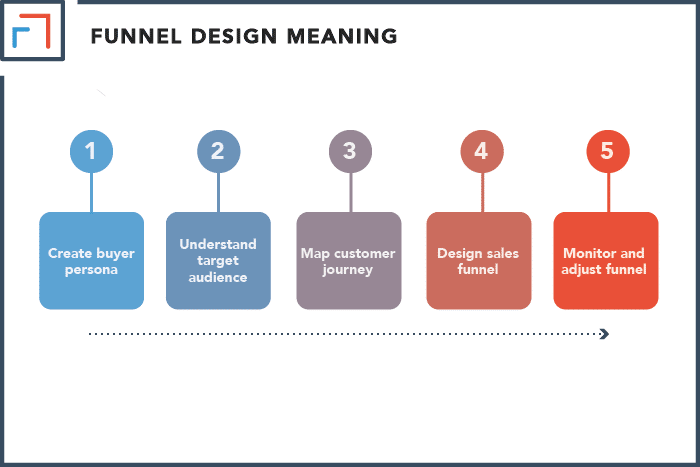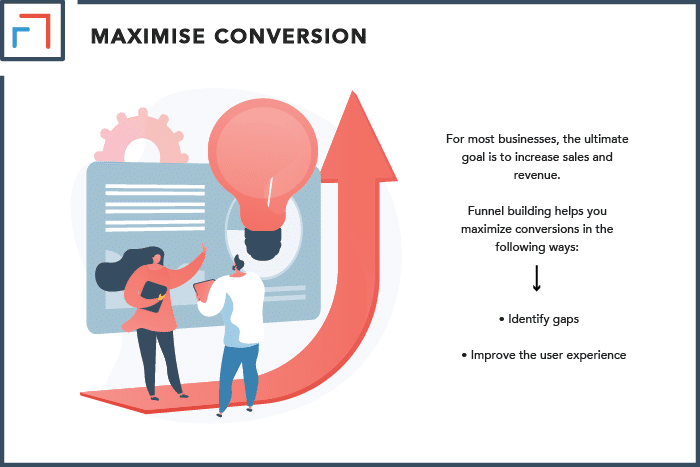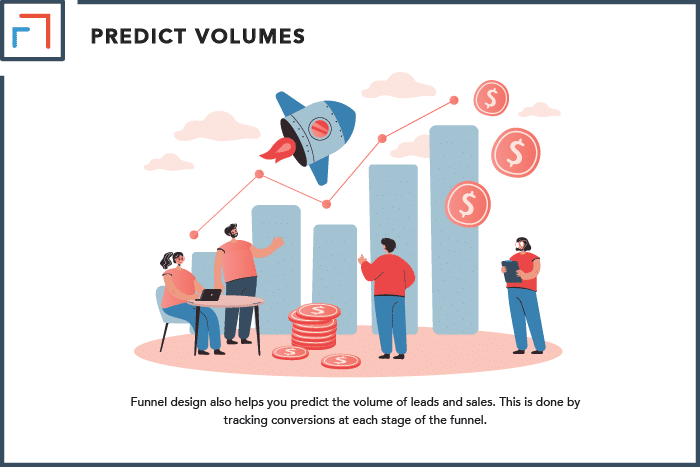Most businesses have an established sales process, but not all businesses have a funnel. A sales funnel is essentially the journey your potential customer takes before making a purchase.
Funnel design is the process of creating sales strategies (funnels) tailored to your business. The goal is to maximize conversions by aligning the marketing message with the customer’s needs at each stage of their journey. Apart from that, it helps you identify where to invest marketing efforts.
Funnel design is essential if you want to convert visitors into customers. You need a good process to move them from one stage to the next. Below, we’ll cover the basics of funnel design and its importance in the modern world.
Funnel Design Meaning
When you think about it, every business has some sort of a sales process.
For example, if you are a brick-and-mortar store, potential customers might come to your store, ask questions, and purchase items.
Or, if you are an online store, your prospect finds your products through a search engine, clicks on your ad, visits your website, and purchases items.
Funnel design is the intentional creation of sales strategies that align with your customer’s needs at each stage.
To do that, you need to understand the customer’s journey from start to finish. Let’s look at the process of sales funnel design.
1. First, you need to create buyer personas. These are semi-fictional representations of your ideal customers.
2. Once you understand your target audience well, identify their needs and wants at each stage of their journey.
For example, if you are a travel company, your potential customers might be interested in learning about different destinations, comparing prices, and reading reviews before booking a trip.
3. Now you can map out the customer journey. Once you know the needs and wants of your prospects, you can map out their journey from start to finish.
This will help you identify what needs to be included in your sales funnel.
4. Finally, design the sales funnel itself. Now that you understand your target audience and their journey, you can start creating your sales funnel.
5. As a follow up, make sure you monitor and adjust your funnel. This will help you ensure that your strategies are working and that your sales funnel is effective.
You can also adapt the funnel to fit changing circumstances.

Why is Funnel Design Essential?
1. Align the Marketing Message and Funnel Stage
The primary stages of a sales funnel are:
- Awareness
- Interest
- Desire
- Action
A funnel design helps you align your marketing message with the buyer’s journey.
By understanding the needs and wants of your target audience, you can create a sales funnel tailored to their needs.
In the awareness phase, your goal is to make potential customers aware of your product or service.
Therefore, your marketing message should focus on creating awareness.
If you falter in the awareness stage, it is unlikely that potential customers will move on to the interest stage.
The first impression matters, so ensure your message is clear and concise.
Your objective in the interest stage is to pique potential customers’ curiosity and get them interested in your product or service.
To do that, your marketing message should list the benefits of your product or service.
As the name suggests, the desire stage is when potential customers start to like your product or service.
Therefore, this phase should focus on convincing the prospect that your product or service is the best solution to their problem.
In the action stage, your goal is to get potential customers to take action and purchase your product or service.
You should make it easy for them to buy by providing a simple checkout process and offering discounts or coupons.
2. Maximize Conversions
For most businesses, the ultimate goal is to increase sales and revenue. Funnel building helps you maximize conversions in the following ways:
- Identify gaps: By mapping out the customer journey, you can identify any gaps in your marketing. This will help you determine where potential customers are dropping off. You can then make the necessary changes to keep them interested.
- Improve the user experience: UX is integral to any sales funnel. Funnel building makes it easy for potential customers to find what they are looking for and navigate your pages. Consequently, this leads to improved conversions.
The purpose of the top part of the funnel is to bring in as many potential customers as possible.
As the prospects move down the funnel, they become more qualified/likely to buy.
Therefore, you should tailor your marketing message at each phase to meet their needs.
Building an effective sales funnel sifts through the unqualified leads, so you can focus your time and energy on those who are more likely to convert.

3. Helps Identify Where to Invest
Trial and error marketing methods can be costly, time-consuming, and frustrating.
However, by mapping out your sales funnel, you can identify which marketing strategies are working and where to invest your resources.
Imagine you are running a Facebook ad campaign. You are driving traffic to your website, but there are no conversions.
Instead of just abandoning the campaign, you can step back and figure out where things went wrong.
It could be that your target audience is not on Facebook, or your ad copy is not compelling.
Designing a funnel will help you pinpoint the problem and make the necessary changes.
4. Creates Seamless Processes
Have you ever been on a page or website and had to search for the contact page? Or maybe you filled out a form but never received a response.
These are just some examples of a poor user experience that can frustrate potential customers.
I can’t count the number of times I’ve abandoned a purchase because the process was too complicated or I couldn’t find the contact page.
Unfortunately, this is the case for many prospects, and it often leads to lost sales. Funnel building creates seamless processes that guide users towards your desired goal.
Whether it is making a purchase or subscribing to your newsletter, it comes in handy. By simplifying your funnel, you will provide a positive experience for users.
If the customer has an easy time engaging with your brand, this will ultimately lead to an improved conversion rate.
5. Predict Volumes
Funnel design also helps you predict the volume of leads and sales. This is done by tracking conversions at each stage of the funnel.
By understanding your conversion rate, you can make changes to improve it.
For example, let’s say you are running a Facebook ad campaign and driving traffic to your website.
You are seeing a conversion rate of 7.5%. This means that for every 100 people who visit your website, 7 will take the desired action.
Let’s say you want to increase your conversion rate to 15%. You need to make changes to your website or funnel to do this.
When you make the adjustments, you can track the performance and know whether you’re meeting your goal.
It could be something as simple as adding a pop-up or changing the copy on your landing page.
By making these small changes, you can double your conversion rate and predict the volume of leads and sales.

Key Takeaway
Funnel design is essential for any business that wants to improve its conversion rate.
By mapping out the customer journey, you can identify where potential customers are dropping off and make the necessary changes to keep them interested.
In addition, funnel building creates seamless processes that guide users towards your desired goal. It also helps you predict the volume of leads and sales.
